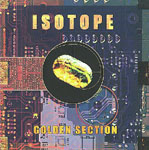Home » Jazz Articles » Album Review » Isotope: Golden Section
Isotope: Golden Section
Formed by guitarist Gary Boyle, Golden Section documents the group's second line-up, with original drummer Nigel Morris, keyboardist Laurence Scott and, most importantly, ex-Soft Machine bassist Hugh Hopper. Culled from performances in London, New York and Bremen from July, 1974 through May, 1975, this line-up spent considerable time on the road combining early Mahavishnu Orchestra's rawness with Weather Report's funkier disposition, all filtered through an Anglo-centric prism made all the more distinctive by Hopper's dense, often fuzz-toned bass.
Boyle's rough-hewn, overdriven tone and fleet-fingered approach might seem, on the surface, to owe much to John McLaughlin's equally visceral playing of the time. The two were, in fact, contemporaries, with nearly parallel careers beginning as in-demand session players before becoming increasingly involved in the nascent progressive jazz movement of late 1960s. Still, there's no denying the influence of Mahavishnu Orchestra on the Phrygian-based "Spanish Sun" where, following a rubato intro where Boyle's lightning-fast runs avoid direct imitation by eschewing many of the Indo-centric intonations that were already creeping into McLaughlin's overall aesthetic. Isotope possessed its own energy, but was less sonically assaultive and grooved in ways early Mahavishnu Orchestra never would.
As much as Mahavishnu Orchestra informs Boyle's tone and playing, as a writer he was clearly more influenced by the funk and germinal world music of Joe Zawinul. The two versions of his fiery "Illusion," that bookend Golden Section, feel very much aligned with Mysterious Traveler-era Weather Report, especially the opening version from the 1975 Bremen show, that also features percussionist Aureo de Souza, who played only briefly with Isotope and is documented here for the first time.
Hopper's compositional contributions also pull Isotope away from direct references to its American counterparts. "Lily Kong" moves along at a furious pace, while the characteristically oblique title track still brings out a funk that Hopper would soon desert for the more experimental territory of 1976's Hopper Tunity Box (Cuneiform, 2007).
Morris is a solid rhythm anchor and Scott a more than capable player, but it's Hopper and Boyle who gave this second line-up of Isotope its personality. Golden Section provides an opportunity to hear experience the more visceral energy of the group in performance, making it a valuable addition to the group's diminutive but worthy discography.
Track Listing
Illusion; Rangoon Creeper; Attila; Spanish Sun; Crunch Cake; Mr. M's Picture; Frog; Attila; Spanish Sun; Lily Kong; Edorian; Golden Section; Illusion.
Personnel
Isotope
band / ensemble / orchestraGary Boyle: guitar; Hugh Hopper: bass; Nigel Morris: drums; Laurence Scott: keyboards; Aureo de Souza: percussion (1-6).
Album information
Title: Golden Section | Year Released: 2008 | Record Label: Cuneiform Records
< Previous
Piano Starts Here: Live at the Shrine
Next >
Anomalies
Comments
About Isotope
Instrument: Band / ensemble / orchestra
Related Articles | Concerts | Albums | Photos | Similar ToTags
For the Love of Jazz
 All About Jazz has been a pillar of jazz since 1995, championing it as an art form and, more importantly, supporting the musicians who create it. Our enduring commitment has made "AAJ" one of the most culturally important websites of its kind, read by hundreds of thousands of fans, musicians and industry figures every month.
All About Jazz has been a pillar of jazz since 1995, championing it as an art form and, more importantly, supporting the musicians who create it. Our enduring commitment has made "AAJ" one of the most culturally important websites of its kind, read by hundreds of thousands of fans, musicians and industry figures every month.



















